The iPhone 7 and iPhone 7 Plus Review: Iterating on a Flagship
by Joshua Ho & Brandon Chester on October 10, 2016 8:00 AM EST- Posted in
- Smartphones
- Apple
- Mobile
- iOS
- iOS 10
- iPhone 7
- iPhone 7 Plus
Display Analysis
Section by Brandon Chester
It's hard to deny the importance of having a great smartphone display. Almost every interaction done with a smartphone involves the display, and we've seen the quality of smartphone displays improve greatly with each year. When looking at the iPhone 7 and 7 Plus at a high level, they appear to use the same displays as the previous two generations of iPhones. The iPhone 7 uses a 1334x750 IPS LCD panel with a pixel density of 326ppi, while the iPhone 7 Plus uses a 1920x1080 IPS LCD panel with a pixel density of 401ppi. However, when you take a deeper look, it's clear that these are not the same displays as those in the iPhone 6 and 6s.
The most obvious improvement that Apple advertises is a substantial increase in peak brightness. Previously both models of the iPhone were rated at 500 nits, while the iPhone 7 and 7 Plus are rated at 625 nits, a 25% increase. Both displays now support the Display P3 color space as well, which makes them the first wide gamut iPhones, and with the color management built into iOS they are also the first smartphones to correctly make the transition to a wider gamut than sRGB. I covered this topics in my review of the 9.7" iPad Pro which was the first wide gamut iOS device, and with the iPhones moving to wide gamut alongside the iPads and iMacs it looks like Apple wants to have it standardized across their entire product line very soon.

iPhone 7 Plus Display Assembly (Image Courtesy iFixit)
Both the improved brightness and wide gamut trace back to a change in the display's LED backlight. A standard blue LED with a yellow phosphor cannot produce the intense green and red wavelengths needed to cover a gamut wider than sRGB, and Apple has most likely used the same system of blue LEDs with green and red phosphors from the iMacs to expand the iPhone's color gamut, with the new LEDs also allowing for a higher peak brightness.
While the color gamut and brightness levels of the displays on this year's iPhones have changed, the resolutions have not. In the case of the iPhone 7, I think this presents an issue. There's something to be said about inexpensive Android phones shipping with sharper displays than Apple's flagship $649 smartphone. Of course, resolution is only one of the metrics that are applicable to a display, but it's an important one. I'll touch on the issue of resolution again later, but for now I'd like to get into the accuracy analysis of the displays on the iPhone 7 and 7 Plus.
Our display testing workflow has changed slightly for this review, with the addition of the Display P3 saturation test. I've used this once before in the iPad Pro 9.7" review, and as more devices adopt the P3 gamut it will continue to show up. In the interest of openness, I also thought it would be worth mentioning that the measurements for these tests were performed by both Josh and I. Josh measured the iPhone 7 Plus using the review unit that we received, and the iPhone 7 results are actually from a unit that I purchased myself in order to assist with testing and analysis for this review.
As always, measurements are performed with an X-Rite i1Pro 2 spectrophotometer, with the exception of black levels which are measured with an i1Display Pro colorimeter to achieve the most accurate results possible in an area where the i1Pro 2 can be somewhat unreliable. Data is collected and examined using SpectraCal's CalMAN software.


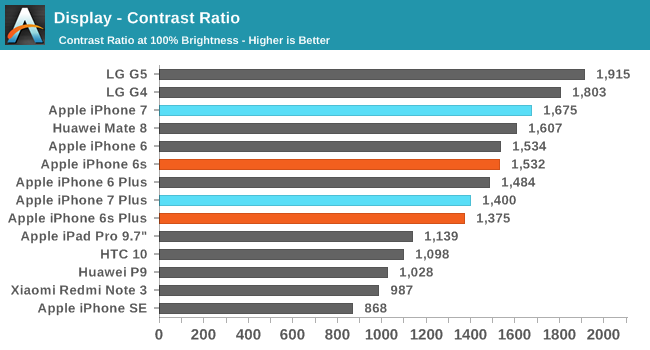
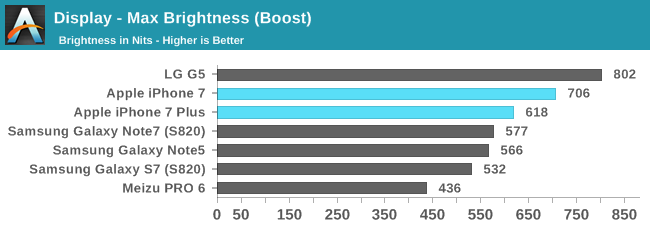
Apple advertises that the iPhone 7 and 7 Plus both have a typical brightness of 625 nits. From one point of view, they've oversold their display in this regard. From another point of view, they've actually undersold it. On the iPhone 7 the maximum brightness by setting the slider manually is just over 600 nits. This isn't that far off of Apple's claimed 625, although falling short by 4% is not insignificant even if it's not a huge gap. The 7 Plus doesn't fare as well, coming in at just over 550 nits, around twelve percent lower than what Apple advertises. At this point one would assume that the displays don't get as bright as claimed, but there's actually something else going on.
Boosting brightness for short period of time when auto brightness is enabled is not a new feature. OLED displays have done it for some time, and modern LCDs like those on LG's flagship smartphones can do it as well. It turns out that Apple has added the same sort of boost mode on the iPhone 7 and 7 Plus. When the phone's brightness is set to automatic and there's bright ambient lighting the display will push above the maximum brightness in manual mode. On the iPhone 7 Plus it reaches 618 nits, which is right around Apple's claimed 625 nits. The iPhone 7 goes above and beyond, hitting 706 nits in the boost mode, which is 13% higher than what is advertised.
As for black levels, they're in line with the previous generation iPhones, but the fact that the maximum brightness has increased significantly while black levels remain constant means that the contrast ratio has increased. In the case of the 7 Plus the increase isn't very large since the 6s Plus unit we reviewed actually exceeded Apple's rated contrast of 1300:1. For the iPhone 7 the increase is more significant, even though our 6s also exceeded Apple's rating of 1400:1 for the 4.7" iPhone. While neither phone's black levels or contrast are at the level of an AMOLED display, they do quite well among LCDs.
The displays on the iPhone 7 and 7 Plus offer an appreciable improvement in brightness and contrast compared to their predecessors. It's worth noting that previous iPhones had a considerable amount of backlight variance, with Apple rating them for a typical brightness of 500 nits even though some units actually reached as high as 600 nits. Even when compared against the best iPhone 6s and 6s Plus units, the iPhone 7 and 7 Plus will have improved usability outdoors, and in any other circumstance where there's harsh ambient lighting. I do feel somewhat uneasy about Apple advertising the boost brightness as their typical peak brightness, as in the case of the 7 Plus the manual brightness is significantly lower. However, I would imagine that most users keep auto brightness enabled, so while I don't necessarily agree with it from a marketing standpoint, it's probably true that the marketing reflects what most users will experience.

Moving on from brightness and black levels, we now come to our standard greyscale accuracy test. This test measures 21 points from 0 to 100% white. As you can see in the image above, the performance of both the iPhone 7 and 7 Plus in this test is remarkable. The RGB balance for each shade is very stable, with only the slightest shift toward blue, leading to a CCT average of 6608K. Like the iPad Pro 9.7", this much closer to sRGB's target white point than older iOS devices, likely owing to the new LED backlight not providing significantly improved efficiency when the display is skewed toward blue. The gamma is quite straight, with only some minor variation past 80% white. Even with that, no error value for an individual shade of grey hits three, and many are close to one, making them essentially indistinguishable from the reference shade.
Receiving a unit with this level of accuracy could lead one to suspect that it's an extraordinarily good sample. However, as I mentioned before, the iPhone 7 I measured was one that I bought on my own, and it would be quite a coincidence if both review units and a purchased unit had the same incredibly high accuracy if that was not typical of all units in general.
With this level of accuracy, it is almost certain that Apple is doing individual calibration of each iPhone 7 display. This is actually not hard to imagine, given that the iPad Pro 9.7" was advertised as being individually calibrated, and engineers at this year's WWDC also claimed that individual calibration is now standard across Apple's product line. This makes sense when you consider the implications of wide gamut and color management. If you apply a single profile to a batch of units, it will not perfectly represent the output characteristics of each display. That would lead to errors when applying a transform to render sRGB content properly on the wide gamut display, as you would be translating values based on output values that were only close to those of the actual display. I actually ran into this exact issue in my recent review of Lenovo's X1 Yoga OLED, which has a wide gamut display without per-unit calibration. To properly pull off wide color and color management you need to individually calibrate each display, and the incredibly high accuracy is just a bonus.
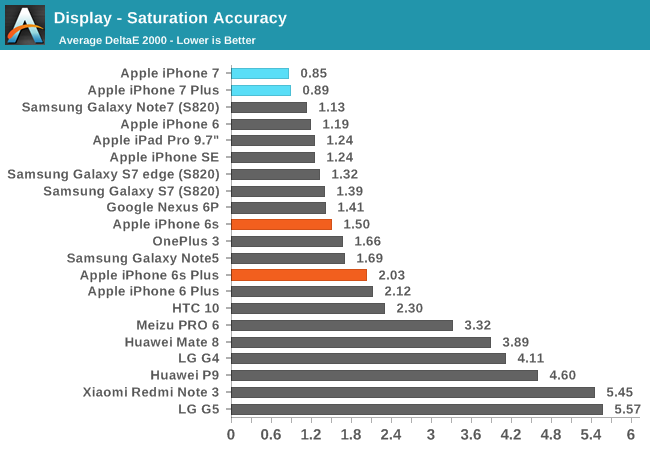
The next test examines the accuracy of primary and secondary colors on a display. Measurements for each color are done in 20% steps from 0 to 100% saturation. This first saturation test targets the sRGB color gamut, with a gamma target of 2.2 and a white point of D65. In this case I really don't have anything to say about the iPhone 7 and 7 Plus because they are the most accurate displays on record in this test. For all but three or four colors the human eye would not be able to distinguish the colors on the display from the true reference shade, even if they were put side by side.
The interesting thing about this test is that the accuracy is guaranteed to be high when a vendor ships an individually calibrated wide gamut display on a color managed OS. When individually calibrating a display, your profile is essentially a perfect characterization of the display's output. This means that even if your standards for calibration are relatively relaxed, such as targeting a DeltaE of 3, your sRGB accuracy won't be affected because the transform performed to converted sRGB content to the display's gamut will take into account any differences between the display's output and the true values of the gamut it targets. The two limitations of this are the accuracy of your profiling device when calibrating, and the bit depth of the display, which forces you to map onto a set of values that is likely not as precise as the optimal output value unless you have some theoretical 16bit per channel display. As you can see from the results, neither of these are a truly significant issue.
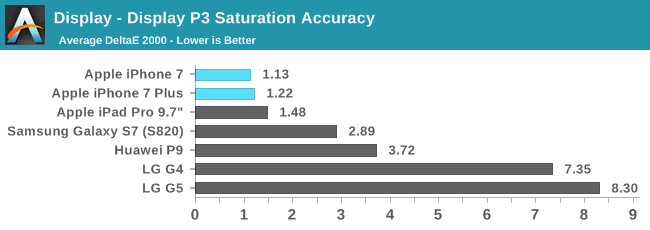
This saturation test uses the same methodology as the previous one, but it targets the DCI-P3 color gamut with a gamma of 2.2 and a white point of D65. These values deviate from the DCI-P3 standard for digital cinema, but a gamma of 2.2 is most appropriate for a mobile device's viewing conditions, and D65 is the standard white point for all gamuts that users will be used to, with the 2.6 gamma and non-standard "D63" white point for DCI-P3 being chosen for the viewing conditions of a dark theatre. Apple describes this adaptation of the DCI-P3 standard Display P3, and it appears to be what other vendors have also settled on in order to expand on the tonal range of the sRGB color space without changing the white point or gamma.
In this test the iPhone 7 and 7 Plus lead the pack once again. There are some minor errors in low green saturations, but neither are truly significant. The 9.7" iPad Pro is right behind them, and the best comparable Android device is the Galaxy S7 with a DeltaE of 2.89. It's worth mentioning that Samsung doesn't actually advertise P3 gamut support, so the fact that their wide gamut mode is close is impressive and suggests that they had it in mind but didn't attempt to provide incredibly high levels of accuracy in that mode. Meanwhile, LG explicitly advertises DCI-P3 gamut support, but regardless of which gamma you use it fails miserably because the green and red primaries aren't even close to the DCI-P3 primaries.

Last is the GretagMacbeth ColorChecker test. This test examines the accuracy of 24 colors that are commonly found in nature, which makes it a good metric for how accurately a display can render color mixtures that have red, green, and blue color components. Like all the other tests, the iPhone 7 and 7 Plus have industry-leading accuracy. Most colors are so close to the reference shade that it's not possible to tell the difference, and the largest errors in are the bright shades of grey which are still below the general target of three, but not quite as low as the rest of the patterns.
I find it very difficult to come to a single verdict on the iPhone 7's display. In the case of the 7 Plus I don't have any hesitation when describing it as a great mobile display, and certainly the most accurate on record. Whether or not it's the best mobile display is debatable, as Samsung provides serious competition with their AMOLED displays which benefit from perfect blacks. However, I think AMOLED's color shifting off angle puts it at a disadvantage, and Samsung is in the unfortunate situation of having to deal with Android not having any form of color management, which means that the wide color modes that their AMOLED displays have available are not truly useful. Apple's control over the hardware and software stack allows them to provide tools for creating wide color content without compromising the visual integrity of existing sRGB content, and that makes the display decidedly more future-proof.
All of the above statements apply to the iPhone 7's display, except for the one about being future-proof. That statement is true as far as color is concerned, but it's definitely not true of the display's sharpness. Apple's smartphones have remained at a pixel density of 326ppi for over six years. At the time, that pixel density was much greater than anything the competition could put out, and it wasn't matched until around eighteen months after release. Nowadays, nearly every Android device has moved far past Apple in this regard, including mid-range devices that cost $200.
The resolution of the iPhone 6 seemed reasonable at a time where technologies like Auto Layout had not been embraced by the development community, and existing bitmaps were designed for a 2x rendering scale. With the iPhone 6s it seemed suspect, but the phone brought many other substantial upgrades that made it possible to overlook the relatively low-resolution display. With the iPhone 7 releasing in late 2016, I really don't know what Apple's excuse is. It's entirely possible that they would not have been able to meet their brightness target if they moved the 4.7" iPhone to a higher resolution, but I am confident that it would not have posed an issue for the move to wide gamut, which is just related to the spectral output of the LED backlight. HTC showed that a 4.7" 1080p panel was possible back in early 2013 with the One M7, and anyone who owned it can attest to how much sharper the rendering is than on Apple's 1334x750 displays.
The 4.7" iPhone 7's display is definitely an improvement over its predecessor. The significant increase to brightness, and subsequent increase to contrast are both appreciated. The move to wide color is setting the foundation for future wide color content, as well as existing content that will be shot on the iPhone 7's own camera. The improved calibration makes it the most accurate smartphone display on the market. Even so, I think the area that really needed improvement was the sharpness of the display, and that remains the same as it was in 2010.


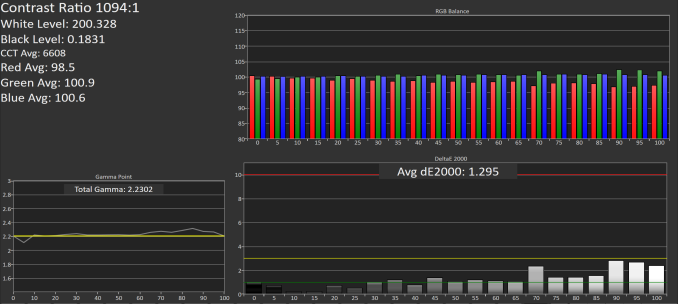
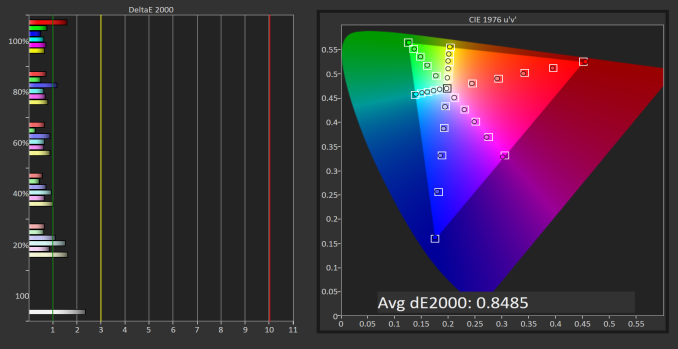
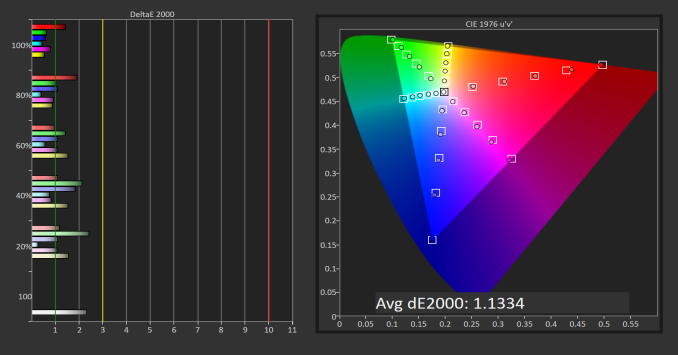
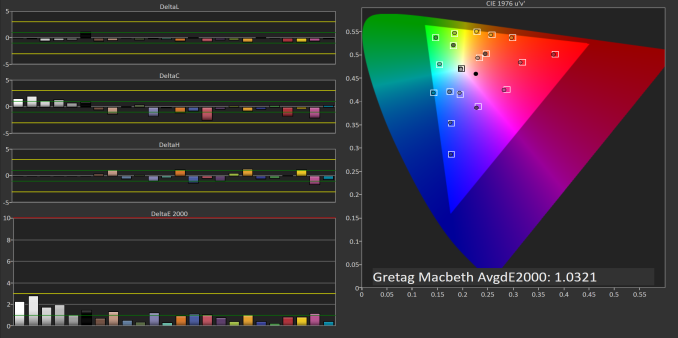








377 Comments
View All Comments
MykeM - Tuesday, October 11, 2016 - link
He's probably referring to the Galaxy S6 Edge which is 0.1mm thicker than the iPhone 6 (7mm vs 6.9mm).doubledeej - Monday, October 10, 2016 - link
It's hard to take the article seriously when it says that the removal of the headphone jack "doesn't really matter." There are a ton of users out there that are completely unsatisfied with the terrible sound quality of the included headphones, and the AirPods are no better. And there are other issues as well.Those interested in high quality sound, who are the most invested in actually wanting a headphone jack, will have better quality headphones they'll want to use. (I, for example, have never removed the EarPods from the iPhone box.) Yes, Apple includes an adapter (gag!), but that's just one more thing we'll forget to bring with us when we leave home, or to get lost and have to be replaced. Adapters are a horrible solution.
It's even worse for those of us that actually connect our phones into high quality audio systems. Again, we're stuck (or in my case, would be stuck) with using an adapter, and not being able to charge the phone at the same time.
Wireless is NOT the same thing. Wireless sound quality always suffers. And having to remember to charge one more device, and worry about one more battery wearing out, just isn't an acceptable solution. Not to mention that you can't use wireless headphones on an airplane.
Apple's decision to remove the headphone jack was just dumb. I, for one, have forgone getting the iPhone 7 specifically for that reason, even though I've purchased every other model since it became available on my carrier. And unless the headphone jack returns, the 6S will be my last.
Some will argue that "wireless is the future" but it's a mediocre substitute at best for a reliable, simple connection that has been proven over time. Simple is a good thing. It means it just works. Some may call the headphone jack a relic, but we use old relics of technology all of the time. Being old doesn't make it bad. The wheel, for example, has been around for millennia, but you don't really see very many people pushing to replace it with something else. Wireless headphones are far more complicated: encoder -> transmitter -> antenna -> antenna -> receiver -> decoder -> analog conversion -> amplifier -> headphone instead of digital -> analog conversion -> amplifier -> headphone.
eastpoint - Tuesday, October 11, 2016 - link
i love hifi audio and i have a pretty nice set of cans i paid a pretty penny for. I have so far left the adapter connected to my headphones without problem. why? because its fundamentally something i have to have a wired connected to anyway so its no big deal. i also purchased an additional adapter for my home setup and left it connected to that as well. sure i could sit and complain about it but the solution is simple enough and low cost enough that its no big deal. I could have complained more but it came with a free one in box so it left me actually losing no functionality with purchase so to me its beating a dead horse over nothing. You may not like the solution but there is one and its a really simple one at that.ACM.1899 - Thursday, October 13, 2016 - link
they removed the 3.5mm jack and what did they add instead? at least a built in dac (like HTC 10, v10 or v20) would have been nice.i've heard the sound through the dongle isn't as good as previous.
or bluetooth headphones (in general) are not as good as analog headphones (with the same price).
and i know it's a smartphone, not a pro music player.
every time Apple does something stupid we say it's because of this
or that
or it's a dead horse
or for that you can do this
or it's the future....
but WHY?
for now the only (main) reason is marketing.(Apple & Beats)
it looks like we are buying a better iPhone with the same price as before but after a year (or 6 months) you'll be forced to buy another dongle or BT headphone , even then you'll still think that you bought a better phone, and that's sad...
as long as a good BT headphone is not the same price as a good analog headphone , i don't want them.
until then the 3.5mm jack should have not been removed.
at least i don't need that bs taptic engine...
Constructor - Monday, October 17, 2016 - link
It's rather simple, and very likely exactly what they've been saying all along: To make room for other components, such as the bigger camera, the bigger battery, the bigger Taptic Engine and apparently also the pressure interface for the barometer.Engineering is always a matter of compromises, and in a smartphone size, weight and battery life make all compromises difficult to reconcile. And in the fight for future improvements the built-in headphone jack got kicked to the curb to allow for the other improvements.
Any develpper worth their salt knows these kinds of decisions from experience, and users waffling on about "marketing" or "greed" almost always have us roll our eyes. Developing complex machinery is a tough business and not for the faint of heart; Very few manufacturers allow their developers to pursue new opportunities as ruthlessly as Apple does. And so far they've got a pretty good track record of mostly being right in hindsight (although some people still keep moaning about the buil-in serial ports or floppy drives of old).
Dbarua - Monday, October 10, 2016 - link
AIDA reports the gpu is the power vr 7XT 7600 6 cores. That would make it the same as the iPad pro with half the number of clusters. Also as expected I have a model 1784 and the modem is a n Intel 7360Ryan Smith - Tuesday, October 11, 2016 - link
For what it's worth, AIDA is just guessing. It's not like on the PC where you can poke registers and get a definitive result, rather the program is just querying its database. It's an educated guess, but reality is a bit more nuanced than simply calling it Series 7XT.just4U - Tuesday, October 11, 2016 - link
I've read every single iPhone review by Anandtech thru the years.. and never owned one. I've used others briefly but never found anything interesting enough to bite the bullet and get one for myself. Maybe it's a question of what your used to?I went from a Mike Phone (work) to a blackberry to S2, S4, and S6. Course I also owned a brick!! back in the early 90s but that's neither here nor there..
Code.Red - Tuesday, October 11, 2016 - link
I have the iPhone 7 and noticed the animation stuttering issue when closing apps as well, but am struggling to understand the explanation given for it in the article. The iPhone 6 and 6S do not stutter in the same animation on iOS 10, so why does the new home button make a difference there? I can press the 6S' physical button and the 7's solid state button at the same rate and the same timing, so what about having a solid state button changes the way the animation works?UtilityMax - Wednesday, October 12, 2016 - link
I think the iPhones were truly interesting in their earlier years, when their iOS was vastly superior to a repetitively chaotic android that was still playing a catch up. However, around 2012-2013 the convergence of the OSes was pretty close, and the Android hardware made a massive leap by introducing large screen smartphones while Apple continued being stuck with relatively small iphones until iPhone 6.